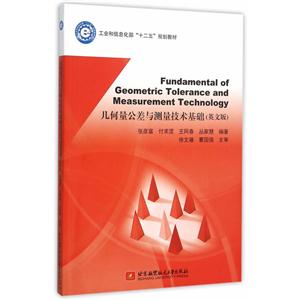chapter 1 introduction 1.1 interchangeability 1.1.1 interchangeability and its advantages 1.2 standardization 1.2.1 standard and standardization 1.2.2 related standards on geometrical interchangeability 1.3 series of preferred values 1.4 what we can learn from this course questions excercisechapter 2 limits and fits of plain workpiece 2.1 basic terms and definitions 2.1.1 terms and definitions about geometrical features 2.1.2 shaft and hole 2.1.3 terms and definitions about size, deviation, tolerance 2.1.4 terms and definitions about fits 2.2 standards of limits and fits 2.2.1 fit system 2.2.2 symbols, designation and indication on engineering drawings 2.2.3 standard tolerance series 2.2.4 series of fundamental deviation 2.2.5 standardization of tolerance classes and fits 2.3 selection of limits and fits 2.3.1 selection of basic system of fit 2.3.2 selection of standard tolerance grades 2.3.3 selection of fits 2.3.4 calculation method 2.4 general dimension tolerance 2.4.1 general tolerances of linear sizes 2.4.2 indication of general tolerance on drawing 2.4.3 general tolerance grades and values questions exerciseschapter 3 fundamentals of geometrical quantity measurement 3.1 introduction 3.1.1 concept of measurement and inspection 3.1.2 measuring processing 3.2 measurement standard~datum~data and dissemination of length and angle .. 3.2.1 standard of length and angle 3.2.2 dissemination system of length and angle 3.2.3 gauge blocks and their applications 3.3 metrological equipment and measurement methods 3.3.1 metrological equipment 3.3.2 measurement methods 3.4 measurement error and data treatment 3.4.1 designation of measurement error 3.4.2 source of measurement error 3.4.3 kinds and properties of measurement error 3.4.4 measurement accuracy/precision questions exerciseschapter 4 geometrical tolerances 4.1 general 4.1.1 cause of geometrical error and effects on performance 4.1.2 basic terms and definitions 4.1.3 symbols and characteristics of geometrical tolerances 4.1.4 geometrical tolerance zone 4.2 indication of geometrical tolerance on engineer drawings 4.2.1 tolerance frame 4.2.2 indication of datum on engineering drawings 4.2.3 indication of toleranced features 4.2.4 theoretical exact dimension (ted) 4.3 definition of geometrical tolerances 4.3.1 definition and characteristics of form tolerances 4.3.2 definition and characteristics of orientation tolerances 4.3.3 definition and characteristics of location tolerance 4.3.4 definition and characteristics of run-out tolerance 4.4 tolerance principles 4.4.1 terms and definition about tolerance principle 4.4.2 independency principle 4.4.3 envelope requirement (er) 4.4.4 maximum material requirement (mmr) 4.5 assessment and measurement of geometrical deviations 4.5.1 assessment of geometrical deviation 4.5.2 establishment and embodiment of datum 4.5.3 measuring prescriptions of geometrical deviations 4.6 selection of geometrical tolerance 4.6.1 general 4.6.2 selection of datum 4.6.3 selection of geometrical principle 4.6.4 selection of geometrical tolerance value 4.7 general geometrical tolerances 4.7.1 general geometrical tolerances grades 4.7.2 indication of general geometrical tolerance questionschapter 5 surface roughness 5.1 introduction 5.2 basic terms and definitions 5.3 main evaluation parameters of surface roughness 5.3.1 amptitude parameters (peak and vallye) 5.3.2 spacing parameters 5.3.3 curves and relative parameters 5.4 principles for selecting surface roughness parameters 5.5 graphical symbols and notation 5.6 indications of surface texture requirements on engineering drawing 5.7 measurement techniques 5.7.1 method of comparing with standard sample 5.7.2 light section method 5.7.3 interferometric method 5.7.4 stylus instruments 5.7.5 optical instruments exerciseschapter 6 measurement of plain workpieces 6.1 basic concepts 6.1. i workpiece inspection principles, safety margins and acceptance limits 6.1.2 selection of measurement tools 6.2 plain limit gauges 6.2.1 functions and kinds of plain limit gauges 6.2.2 design principle of plain limit gauges 6.2.3 tolerance of the plain limit gauge 6.2.4 design steps and calculationof the limits size questions exerciseschapter 7 tolerances and fits of rolling bearing 7.1 general 7.2 introduction of rolling bearings 7.2.1 construction and classification of rolling bearing 7.2.2 analysis of working performance of rolling bearings 7.2.3 internal clearance of rolling bearings 7.2.4 tolerance grades of rolling bearings and applications 7.2.5 tolerance zone of rolling bearings 7.3 selection of tolerance and rolling bearings fits 7.3.1 selection of rolling bearing fits 7.3.2 geometrical tolerance requirements for shafts and holes fitted with rolling bearings 7.3.3 surface roughness requirements of shafts and holes fitted with rolling bearings exerciseschapter 8 tolerances and measurement of cylinder screw 8.1 introduction 8. 1.1 classification and requirements of thread 8.1.2 basic common thread tooth type and geometrical parameters 8.2 influence of thread geometrical deviation on thread interchangeability 8.2.1 influence of pitch diameter deviation △d2a, △d2a on thread interchangeability 8.2.2 influence of pitch deviation on screw thread interchangeability 8.2.3 influence of thread half angle deviation △α/2 on screw thread interchangeability 8.2.4 calculation of virtual pitch diameter 8.2.5 conditions to guarantee the screw thread interchangeability 8.3 general purpose screw threads-tolerance zones for screw thread 8.3.1 tolerance grades 8.3.2 fundamental deviation (tolerance positions) 8.3.3 length of thread engagement 8.3.4 thread selection, tolerance zone and fits 8.3.5 thread marking 8.3.6 inspection of screw thread questions exerciseschapter 9 tolerances and fits of keys and splines 9.1 tolerances and fits of rectangular keys connection 9.1.1 introduction of rectangular keys connection structure 9.1.2 tolerance and fits of the rectangular key connection 9.2 tolerances and fits of straight-sided spline connection 9.2.1 introduction of spline connection structure 9.2.2 designation 9.2.3 tolerances and fits of straight-sided spline connections questions exerciseschapter 10 accuracy design of cylindrical involute gear 10.1 general 10.2 evaluation parameters of cylindrical involute gear 10.2.1 definition of evaluation parameters 10.2.3 allowable values of every deviation of cylindrical involute gears 10.3 accuracy design of cylindrical involute gears 10.3.1 selection of accuracy grade 10.3.2 selection of evaluation parameters 10.3.3 detemination of gear backlash 10.3.4 detemination of gear pair precision 10.3.5 detemination of gear blank accuracy questionschapter 11 dimension chain 11.1 basic concepts and terms of dimension chain 11.1.1 basic concepts and terms 11.1.2 forms of dimension chain 11.1.3 establishment of dimension chain 11.2 tolerance calculations of size chain 11.2.1 types of dimension chain calculation 11.2.2 extreme value method 11.2.3 probability method 11.3 methods to fulfill tolerance stacks of size chain 11.3.1 complete interchange method 11.3.2 large number interchange method 11.3.3 grouping method questions exercisesreferences




















